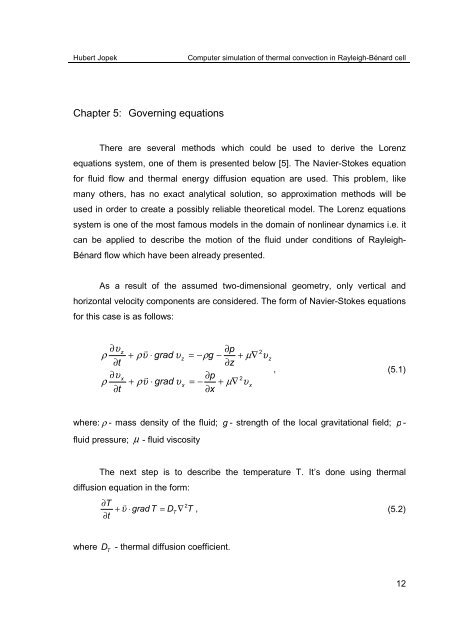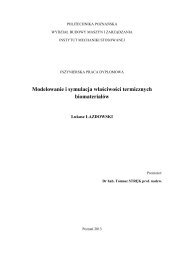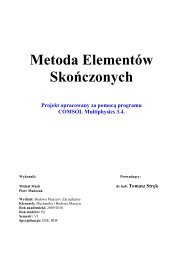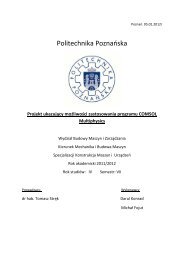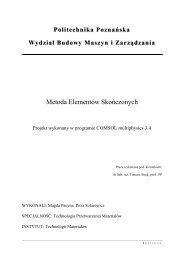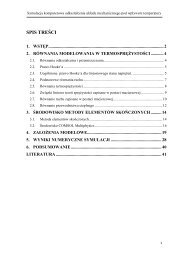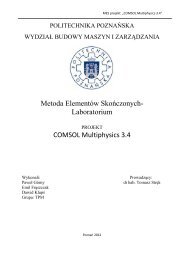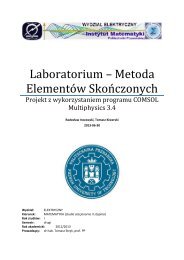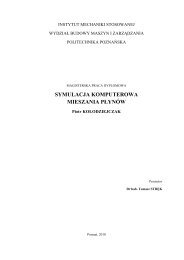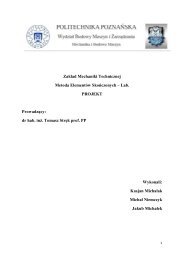Computer simulation of thermal convection in Rayleigh-Bénard cell ...
Computer simulation of thermal convection in Rayleigh-Bénard cell ...
Computer simulation of thermal convection in Rayleigh-Bénard cell ...
You also want an ePaper? Increase the reach of your titles
YUMPU automatically turns print PDFs into web optimized ePapers that Google loves.
Hubert Jopek<br />
<strong>Computer</strong> <strong>simulation</strong> <strong>of</strong> <strong>thermal</strong> <strong>convection</strong> <strong>in</strong> <strong>Rayleigh</strong>-<strong>Bénard</strong> <strong>cell</strong><br />
Chapter 5: Govern<strong>in</strong>g equations<br />
There are several methods which could be used to derive the Lorenz<br />
equations system, one <strong>of</strong> them is presented below [5]. The Navier-Stokes equation<br />
for fluid flow and <strong>thermal</strong> energy diffusion equation are used. This problem, like<br />
many others, has no exact analytical solution, so approximation methods will be<br />
used <strong>in</strong> order to create a possibly reliable theoretical model. The Lorenz equations<br />
system is one <strong>of</strong> the most famous models <strong>in</strong> the doma<strong>in</strong> <strong>of</strong> nonl<strong>in</strong>ear dynamics i.e. it<br />
can be applied to describe the motion <strong>of</strong> the fluid under conditions <strong>of</strong> <strong>Rayleigh</strong>-<br />
<strong>Bénard</strong> flow which have been already presented.<br />
As a result <strong>of</strong> the assumed two-dimensional geometry, only vertical and<br />
horizontal velocity components are considered. The form <strong>of</strong> Navier-Stokes equations<br />
for this case is as follows:<br />
∂υ<br />
z<br />
ρ<br />
∂t<br />
∂υ<br />
x<br />
ρ<br />
∂t<br />
r<br />
+ ρυ ⋅ grad υ<br />
r<br />
+ ρυ ⋅ grad υ<br />
z<br />
x<br />
∂p<br />
2<br />
= −ρg<br />
− + µ ∇ υ<br />
z<br />
∂z<br />
, (5.1)<br />
∂p<br />
2<br />
= − + µ ∇ υ<br />
x<br />
∂x<br />
where: ρ - mass density <strong>of</strong> the fluid; g - strength <strong>of</strong> the local gravitational field; p -<br />
fluid pressure; µ - fluid viscosity<br />
The next step is to describe the temperature T. It’s done us<strong>in</strong>g <strong>thermal</strong><br />
diffusion equation <strong>in</strong> the form:<br />
∂T<br />
∂t<br />
2<br />
+<br />
r υ ⋅ grad T = D ∇ T , (5.2)<br />
T<br />
where<br />
D<br />
T<br />
- <strong>thermal</strong> diffusion coefficient.<br />
12


